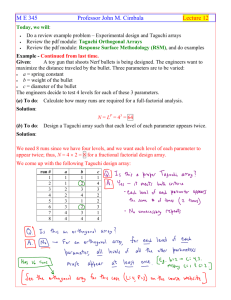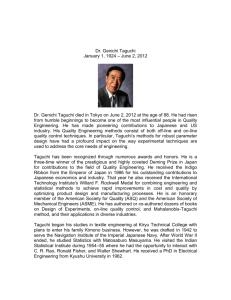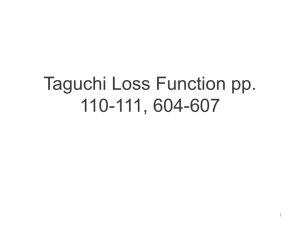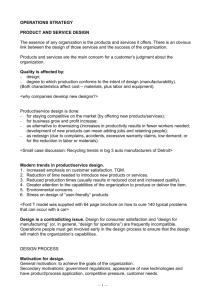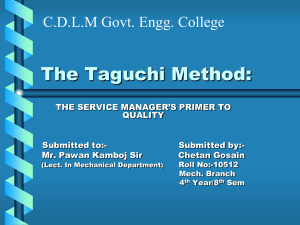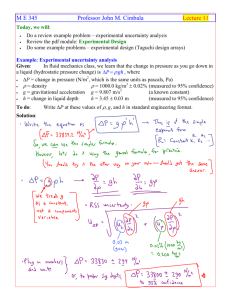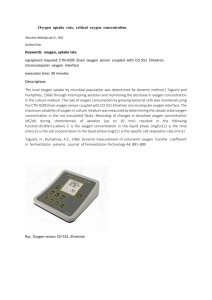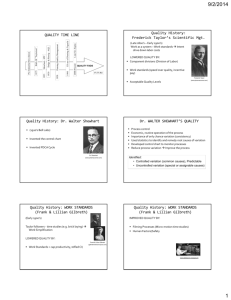Chapter 05
advertisement
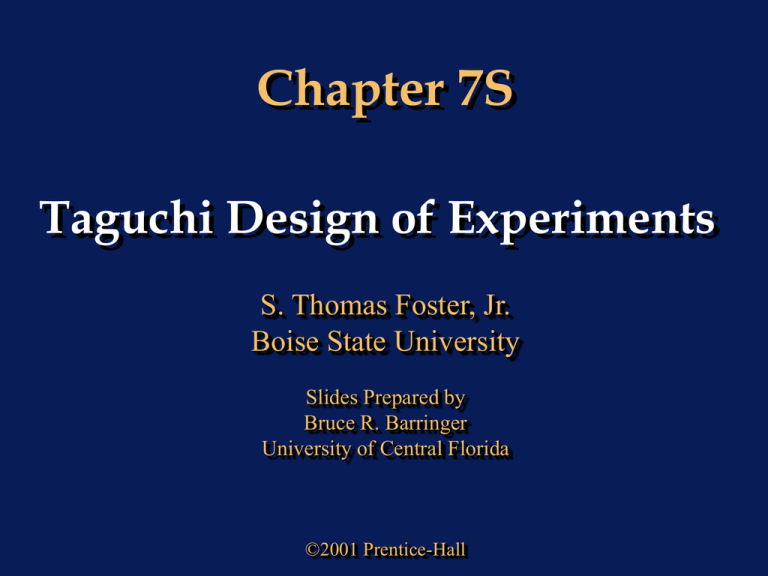
Chapter 7S Taguchi Design of Experiments S. Thomas Foster, Jr. Boise State University Slides Prepared by Bruce R. Barringer University of Central Florida ©2001 Prentice-Hall Chapter Overview • Taguchi Design of Experiments • Background of the Taguchi Method • The Taguchi Process © 2001 Prentice-Hall Transparency 7S-2 Taguchi Design of Experiments • Many different factors, inputs, or variables need to be considered when making a product. • For example, suppose you wanted to bake a cake, you ask: -- How much flour should you use? -- How many egg? -- How long should it bake? -- At what temperatures should you set the oven? • However, there is a better way to design an experiment to find out the best combination of variables to make your product. © 2001 Prentice-Hall Transparency 7S-3 Taguchi Design of Experiments • Taguchi Method – The Taguchi method is a standardized approach for determining the best combination of inputs to produce a product or service. – This is accomplished through design of experiments (DOE). DOE is an important tool in the arsenal of tools available to the design and process engineer. © 2001 Prentice-Hall Transparency 7S-4 Taguchi Design of Experiments • It provides a method for quantitatively identifying just the right ingredients that go together to make a high-quality product or service. • Taguchi approaches design from four perspectives: robust design, concept design, parameter design, and tolerance design. © 2001 Prentice-Hall Transparency 7S-5 Taguchi Design of Experiments • Robust Design – The Taguchi concept of robust design states that products and services should be designed so that they are inherently defect free and of high quality. The concept is not necessarily new. – Taguchi’s approach for creating robust design is through a three-step method consisting of concept design, parameter design, and tolerance design. © 2001 Prentice-Hall Transparency 7S-6 Taguchi Design of Experiments • Robust Design (continued) – Concept design is the process of examining competing technologies to produce a product. – Concept design includes process technology choices and process design choices. – Appropriate choices in these areas can reduce production costs and result in high quality products. © 2001 Prentice-Hall Transparency 7S-7 Taguchi Design of Experiments • Robust Design (continued) – Parameter design refers to the selection of control factors and the determination of optimal levels for each of the factors. – Control factors are those variables in a process that management can manipulate. – Control factors do not affect production costs. – Optimal levels are the targets or measurements for performance. – The goal is to fine the most efficient process and service design. – These parameters can be determines through experimentation. © 2001 Prentice-Hall Transparency 7S-8 Taguchi Design of Experiments • Robust Design (continued) – Tolerance design deals with developing specification limits. – Tolerance design occurs after parameter design has been used to reduce variation and the resulting improvement has been insufficient. – This often results in an increase in production costs. • Of these four design considerations, the Taguchi method primarily focuses on parameter design. © 2001 Prentice-Hall Transparency 7S-9 Background of the Taguchi Method Slide 1 of 7 • History and Impact – The Taguchi method was first introduced by Dr. Genichi Taguchi to AT&T Bell Laboratories in 1980. – Thanks to its wide acceptance and utilization, the Taguchi method for improving quality is now commonly views as comparable in importance to statistical process control(SPC), the Deming approach, and the Japanese concept of total quality control. © 2001 Prentice-Hall Transparency 7S-10 Background of the Taguchi Method • History and Impact – Dr. Taguchi’s method is a continuation of the work in quality improvement that began with Shewhart’s work in statistical quality control (SQC) and Deming’s work in improving Japanese quality. © 2001 Prentice-Hall Transparency 7S-11 Background of the Taguchi Method • The Taguchi method provides: 1. A basis for determining the functional relationship between controllable product or service design factors and the outcomes of a process. 2. A method for adjusting the mean of a process by optimizing controllable variables. 3. A procedure for examining the relationship between random noise in the process and product or service variability. © 2001 Prentice-Hall Transparency 7S-12 Background of the Taguchi Method Slide 2 of 7 • Taguchi Definition of Quality – In Taguchi terms, ideal quality refers to a reference point or target value for determining the quality level of a product or service. – Ideal quality is delivered if a product or tangible service performs its intended function throughout its projected life under reasonable. – Ideal quality is a function of customer perceptions and satisfaction. © 2001 Prentice-Hall Transparency 7S-13 Background of the Taguchi Method Slide 3 of 7 • Quality Loss Function (QLF) – In Figure S7.1 a measurement is taken of the critical product characteristic. This is shown in the figure as A. If A is within the specification limits, the traditional conclusion was that it was not a problem. © 2001 Prentice-Hall Transparency 7S-14 Background of the Taguchi Method • However, point A is closer to being out of specification than to being at the target measurement. This means that over time, it might cause a problem. Taguchi calls this potential for problem a potential loss to society. • Taguchi identifies these losses to society not only in terms of rejection, scrap, or rework but also in terms of pollution that is added to the environment, products that wear out too quickly, or other negative effects that occur. © 2001 Prentice-Hall Transparency 7S-15 Background of the Taguchi Method Slide 4 of 7 Figure S7.1 Classical QC-Step Function Q(c) Scrap Cost LSL USL Target A © 2001 Prentice-Hall Transparency 7S-16 Background of the Taguchi Method Slide 5 of 7 • Quality Loss Function (continued) – To quantify loss to society, Taguchi used the concept of a quadratic loss function (QLF). Figure S7.2 shows Taguchi’s concept of a quadratic loss function. The figure shows that any variation from the target of six ( where T = 6) results in some loss to the company. © 2001 Prentice-Hall Transparency 7S-17 Background of the Taguchi Method • Quality Loss Function (continued) – The quality loss function focuses on the economic and societal penalties incurred as a result of purchasing a nonconforming product. – Losses may include maintenance costs, failure costs, ill effects to the environment such as pollution, or excessive costs of operating the product. © 2001 Prentice-Hall Transparency 7S-18 Background of the Taguchi Method Slide 6 of 7 Figure S7.2 Taguchi Quadratic Loss Function © 2001 Prentice-Hall Transparency 7S-19 Quality Loss Function (QLF) • The QLF is determined by first putting the constant: -- K = C/T2 ----------------------------------------------- (S7.1) -- After computing the constant, next compute: 1. Nominal the better L(y) = K * V2 = K * (y – m)2 m is target value 2. Lower the better L(y) = K * y2 3. Larger the better L(y) = (C*T2 )/y2 © 2001 Prentice-Hall Transparency 7S-20 Quality Loss Function (QLF) • Example S7.1 m = 6, V = 1/6, C = 200, T = 0.5, 2 so, K = 200/0.5 = 800 2 L(y) = 800 * (1/6) = $22.22/unit © 2001 Prentice-Hall Transparency 7S-21 The Taguchi Process • As shown in Figure S7.3, a series of six steps is followed in the initial phase of the Taguchi experiment. © 2001 Prentice-Hall Transparency 7S-22 The Taguchi Process • Figure S7.3 Taguchi Process © 2001 Prentice-Hall Transparency 7S-23 The Taguchi Process Slide 1 of 7 • Step 1: Problem identification – First, the production problem must be identified. The problem may have to do with the product process or the service itself. • Step 2: Brainstorming session – Second, a brainstorming session to identify variables that have a critical affect on service or product quality takes place. © 2001 Prentice-Hall Transparency 7S-24 The Taguchi Process Slide 2 of 7 • Step 2: Brainstorming Session (continued) – The critical variables identified in the brainstorming sessions are referred to by Taguchi as factors. – These may be identified as either control factors (variables that are under the control of management) or signal factors (uncontrollable variation). © 2001 Prentice-Hall Transparency 7S-25 The Taguchi Process • Step 2: Brainstorming Session (continued) – Once these factors have been identified, different levels or setting of the control factors are defined. – At least three levels should be used for each factor in order to identify functional forms (such as interactions) of the effects more clearly. – Noise factors can be measured at the time of the experiment and included in the analysis. © 2001 Prentice-Hall Transparency 7S-26 The Taguchi Process • Step 2: Brainstorming Session (continued) – Once the decision variables are established, objectives of the experiments should be defined. – These objectives are defined as follows: 1. Less the better. 2. Nominal is best. 3. More the better. © 2001 Prentice-Hall Transparency 7S-27 The Taguchi Process Slide 3 of 7 • Step 3: Experimental Design – Using the factors, factor levels, and objectives from the brainstorming session, the experiment is designed. The Taguchi method uses off-line experimentation as a means of improving quality. This contrasts with traditional on-line (in process) quality measurement. – As with any experiment, care should be taken in selecting an appropriate number of trials and with the conditions for each trial. – The number of replications to be used in the experiment should be established beforehand. © 2001 Prentice-Hall Transparency 7S-28 The Taguchi Process Slide 4 of 7 • Step 4: Run Experiment – There are different Taguchi analysis approaches that use quantitatively rigorous techniques such as analysis of variance (ANOVA), signal-to-noise ratios (S/N), and response charts. These approaches, although not always theoretically sound, are useful in engineering related projects involving engineered specifications, torques, and tolerances. © 2001 Prentice-Hall Transparency 7S-29 The Taguchi Process • Step 4: Run Experiment – For service, the approach advocated by Ross may be the most useful. – The experimental steps used in this methodology are as following. © 2001 Prentice-Hall Transparency 7S-30 Experimental Steps a. Choose the appropriate orthogonal array for the experiment. b. Run the experiment for the appropriate number of replications and record the results. c. Compute average performance levels for each of the factors and levels. d. Plot the average responses on a response chart showing the best outcomes in accordance with the objective of the experiment. © 2001 Prentice-Hall Transparency 7S-31 The Taguchi Process Slide 5 of 7 • Step 5: Analysis – Experimentation is used to identify the factors that result in closest-to-target performance. If interactions between factors are evident, two alternatives are possible. Either ignore the interactions (there is inherent risk to this approach) or, provided the cost is not prohibitive, run a full factorial experiment to detect interactions. The full factorial experiment tests all possible interactions among variables. © 2001 Prentice-Hall Transparency 7S-32 The Taguchi Process Slide 6 of 7 • Step 6: Confirming Experiment – Once the optimal levels for each of the factors have been determined, a confirming experiment with factors set at the optimal levels should be conducted to validate the earlier results. If earlier results are not validated, the experiment may have somehow been significantly flawed. If results vary from those expected, interactions also may be present, and the experiment should, therefore, be repeated. © 2001 Prentice-Hall Transparency 7S-33 Example S7.2 • Case of the Careless Clerks 1. Company Background 2. Taguchi Experiment 3. Design of the Taguchi Experiment 4. Running the Experiment 5. Experiment Results ( figure S7.4) © 2001 Prentice-Hall Transparency 7S-34
